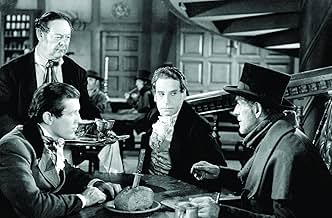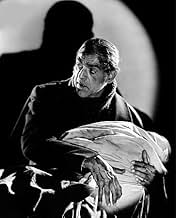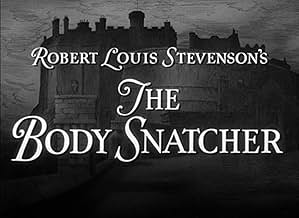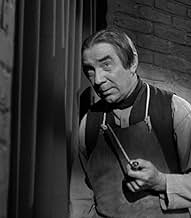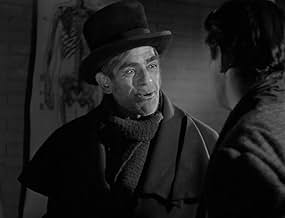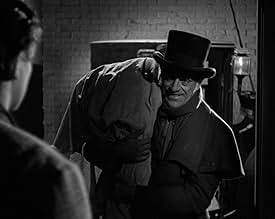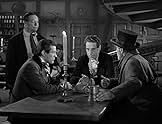VALUTAZIONE IMDb
7,3/10
10.871
LA TUA VALUTAZIONE
Un dottore senza pietà ed il suo giovane studente sono continuamente tormentati dai loro maniacali ritrovatori di cadaveri illegali.Un dottore senza pietà ed il suo giovane studente sono continuamente tormentati dai loro maniacali ritrovatori di cadaveri illegali.Un dottore senza pietà ed il suo giovane studente sono continuamente tormentati dai loro maniacali ritrovatori di cadaveri illegali.
- Regia
- Sceneggiatura
- Star
- Premi
- 3 candidature totali
Paula Corday
- Mrs. Marsh
- (as Rita Corday)
Ted Billings
- Townsman
- (non citato nei titoli originali)
Bobby Burns
- Mourner
- (non citato nei titoli originali)
Robert Clarke
- Richardson - Medical Student
- (non citato nei titoli originali)
Aina Constant
- Maidservant
- (non citato nei titoli originali)
Mary Gordon
- Mrs. Mary McBride
- (non citato nei titoli originali)
Carl Kent
- Gilchrist - Medical Student
- (non citato nei titoli originali)
Milton Kibbee
- Dan
- (non citato nei titoli originali)
Ethan Laidlaw
- Pub Patron
- (non citato nei titoli originali)
Jim Moran
- Angus - Horse Trader
- (non citato nei titoli originali)
Jack Welch
- Boy
- (non citato nei titoli originali)
Recensioni in evidenza
As of this writing, I have seen four of the nine Val Lewton DVD Horror Collection films and this one was, by far, the best.
Henry Daniell, Boris Karloff, Edith Atwater,Russell Wade, Sharyn Moffet and Bela Lugosi all acted well. I had forgotten that Karloff was a decent actor, not just some Frankenstein monster who couldn't deliver a line. He had a creepy voice, too, which lent itself nicely to horror films. I just found him fascinating here.
In addition, this movie had a well-known director, Robert Wise, and the story was adaption of a Robert Louis Steevenson. So, you see, this film had good bloodlines, pun intended. This was not some schlocky Ed Wood B-film. This movie is a high class affair.
I found it more of a crime story than anything else as a doctor (Daniell), trying to further his knowledge and needing human specimens (dead) to continue his research, has his graveyard supply cut off to him and then has to have his helper (Karloff) kill people to provide him the bodies. Meanwhile, a young and more moral student of the doctor, gets wind of what's happening and doesn't share his mentor's view that the "ends justify the means."
At any rate, this a keeper. Like the other Lewton films I've seen, it's well- photographed, too. I can only hope a few of the five I haven't seen yet are this good.
Henry Daniell, Boris Karloff, Edith Atwater,Russell Wade, Sharyn Moffet and Bela Lugosi all acted well. I had forgotten that Karloff was a decent actor, not just some Frankenstein monster who couldn't deliver a line. He had a creepy voice, too, which lent itself nicely to horror films. I just found him fascinating here.
In addition, this movie had a well-known director, Robert Wise, and the story was adaption of a Robert Louis Steevenson. So, you see, this film had good bloodlines, pun intended. This was not some schlocky Ed Wood B-film. This movie is a high class affair.
I found it more of a crime story than anything else as a doctor (Daniell), trying to further his knowledge and needing human specimens (dead) to continue his research, has his graveyard supply cut off to him and then has to have his helper (Karloff) kill people to provide him the bodies. Meanwhile, a young and more moral student of the doctor, gets wind of what's happening and doesn't share his mentor's view that the "ends justify the means."
At any rate, this a keeper. Like the other Lewton films I've seen, it's well- photographed, too. I can only hope a few of the five I haven't seen yet are this good.
In 1831, in Edinburgh, the prominent doctor and professor Dr. Wolfe 'Toddy' MacFarlane (Henry Daniell) buys corpses for his studies and classes of anatomy from the notorious cabman John Gray (Boris Karloff), who is also a body snatcher. When his talented student Donald Fettes (Russell Wade) tells that he will quit medical school since his family cannot afford to support him, MacFarlane hires him as his assistant to permit Fettes to proceed his studies. Fettes meets a little girl that cannot walk anymore due to a coach accident, and he tries to convince Dr. MacFarlane to operate her but the doctor is reluctant. Soon Fettes discovers that Dr. MacFarlane has a secret from his past and Gray blackmails him. When Fettes learns how Gray obtains the corpses for Dr. MacFarlane, he has an inner conflict and does not want to continue as Dr. MacFarlane's protégée. But isn't it too late?
"The Body Snatcher" is a dark and gloomy horror tale with a creepy story about ethic in medicine, or how far a doctor should go in his researches. Boris Karloff has a magnificent performance, maybe the best I have ever seen of this actor. The direction of Robert Wise is sharp and the cinematography in black and white is impressive. My vote is seven.
Title (Brazil): "O Túmulo Vazio" ("The Empty Grave")
"The Body Snatcher" is a dark and gloomy horror tale with a creepy story about ethic in medicine, or how far a doctor should go in his researches. Boris Karloff has a magnificent performance, maybe the best I have ever seen of this actor. The direction of Robert Wise is sharp and the cinematography in black and white is impressive. My vote is seven.
Title (Brazil): "O Túmulo Vazio" ("The Empty Grave")
Robert Louis Stevenson has had a rough going in modern literary tastes. When he died in 1894, he was rightly regarded as one of the finest writers and stylists of his day - for grown-up readers! However, the enmity of a one time friend , W.E.Henley, diminished his reputation. Henley said that Stevenson was too superficial, and was basically a writer of pot-boilers. This view was somewhat softened into a "boy's" writer of adventure stories (TREASURE ISLAND and KIDNAPPED were the titles that usually were pushed as boy's novels).
Actually Stevenson was far from a writer for youths. TREASURE ISLAND has the perplexing, exasperating figure of Long John Silver as it's anti-hero, chum and protector of Jim Hawkins, but mutineer, pirate leader, and murderer. KIDNAPPED does the same with Aleck Breck Stewart, whose weaknesses (such as gambling and drinking) ruin a political mission. He was hardly a simple adventure novelist, anymore than the real Jules Verne was simply a French chap with an outlandish imagination regarding scientific progress.
The movies have done well by Stevenson. TREASURE ISLAND and KIDNAPPED have been made several times, as was THE MASTER OF BALLENTRAE. His novella DR. JECKYLL AND MR. HYDE was made more frequently than any other title of his. In 1931, it earned it's star (Fredric March) the Best Actor Oscar. Even some of the lesser known works have gotten into film: THE WRONG BOX (one of two novels written with Stevenson's stepson Lloyd Osbourne) became a marvelously funny comedy about a scramble over a legacy. THE EBB TIDE was a film with Ray Milland, Lloyd Nolan, Oscar Homolka, and Barry Fitzgerald, and a good television version was made with Robby Coltrane in it. The tales of Prince Florizel of Bohemia from THE NEW ARABIAN NIGHTS became TROUBLE FOR TWO with Robert Montgomery, Rosalind Russell, Frank Morgan, and Reginald Owen. Finally there is this nice gem, THE BODY SNATCHER. It is based on one of Stevenson's best short stories, a moody, psychological drama about the evil that is committed supposedly in the way of greater good.
In most of these films the scripts start out with the novel or short story, but branch out into their own scenarios. Gray, the murderous but sympathetic cab man in the film is (in the story) a drunk who MacFarland actually hates. When he kills Gray for his corpse (for medical study) MacFarland is actually settling a score. The conclusion of the story is similar to the film, except that Gray's mysterious resurrection to confront the frightened MacFarland does not lead to his death, but to his total demoralization. He flees into his own oblivion at the conclusion.
Stevenson was very into history including crime and the vagaries of the law.
It has been noted in the other posts that this story owes much to the crimes of the West Port murderers of 1827-28, William Burke and William Hare (in the film Gray sings a tune about them to the drunken (and doomed) blackmailer Joseph). But this is not unusual for Stevenson. The final blow to Alan Breck Stewart's mission in KIDNAPPED is the hue and cry against him as a suspect in the Appin Murder of 1752, which led to the judicial murder of James "of the Glen" Stewart. The latter story is told in the sequel novel CATRIONA. DR.JECKYLL AND MR.HYDE is based on the story of Deacon Brodie, a wealthy cabinet maker and town councilor of Edinburgh in the 1770s and 1780s, who was a burglar at night, and who was eventually hanged on a a scaffold he had built for the city. Even in his best novel (the unfinished WEIR OF HERMISTON)the title character of Hanging Judge Weir is based on that legendary jurist Lord Braxfield, a man of strong prejudices and harsh statements.
THE BODY SNATCHER was not the first historical movie by Val Lewton's production unit. But THE BODY SNATCHER was the first of three films (all first rate) starring Boris Karloff (the others being ISLE OF THE DEAD and BEDLAM). THE BODY SNATCHER manages to set the period of the 1830s pretty well, although an early distance shot is from some routine film stock and (if you look carefully) shows a car in the distance near a flock of sheep outside of Edinburgh Castle.
The acting is actually quite good, in particular Karloff's Gray and Daniell's astonishing MacFarland. Henry Daniell was one of the best screen villains of his period, in films like CAMILLE (as Baron De Varville) and THE SEA HAWKE (as Wolfingham). He also could do comic villains (Garbitsch in Chaplin's THE GREAT DICTATOR). But this is a rare occasion where he actually shared a full screenplay with a fellow actor.
Daniell's MacFarland is in a battle to the death with Karloff's Gray, one that his mistress knows will destroy both. Both have flaws (Daniell's intellectual arrogance; Karloff's willingness to kill anyone who is expendable). But both are human too. Daniell is aware that his operation on the little girl is "flawless" but nothing improves her ability to walk. All he can do is harshly order the little girl to walk (and she doesn't). Gray sneers at him in their famous scene in the tavern, where Daniell explains his confusion at the failure of a successful operation and hits on the actual missing aspect - Gray knows that the basic cause of life is not something that MacFarland can fix, but the basis of life itself (God or nature itself - something beyond a puny mortal like the doctor). But Gray, for his cynicism and murderous ability, does wish the "wee" one could walk. Oddly enough, hearing his horse move causes the poor girl to walk finally.
It is a fine movie, and gave both Karloff and Daniell a shining moment on the screen.
Actually Stevenson was far from a writer for youths. TREASURE ISLAND has the perplexing, exasperating figure of Long John Silver as it's anti-hero, chum and protector of Jim Hawkins, but mutineer, pirate leader, and murderer. KIDNAPPED does the same with Aleck Breck Stewart, whose weaknesses (such as gambling and drinking) ruin a political mission. He was hardly a simple adventure novelist, anymore than the real Jules Verne was simply a French chap with an outlandish imagination regarding scientific progress.
The movies have done well by Stevenson. TREASURE ISLAND and KIDNAPPED have been made several times, as was THE MASTER OF BALLENTRAE. His novella DR. JECKYLL AND MR. HYDE was made more frequently than any other title of his. In 1931, it earned it's star (Fredric March) the Best Actor Oscar. Even some of the lesser known works have gotten into film: THE WRONG BOX (one of two novels written with Stevenson's stepson Lloyd Osbourne) became a marvelously funny comedy about a scramble over a legacy. THE EBB TIDE was a film with Ray Milland, Lloyd Nolan, Oscar Homolka, and Barry Fitzgerald, and a good television version was made with Robby Coltrane in it. The tales of Prince Florizel of Bohemia from THE NEW ARABIAN NIGHTS became TROUBLE FOR TWO with Robert Montgomery, Rosalind Russell, Frank Morgan, and Reginald Owen. Finally there is this nice gem, THE BODY SNATCHER. It is based on one of Stevenson's best short stories, a moody, psychological drama about the evil that is committed supposedly in the way of greater good.
In most of these films the scripts start out with the novel or short story, but branch out into their own scenarios. Gray, the murderous but sympathetic cab man in the film is (in the story) a drunk who MacFarland actually hates. When he kills Gray for his corpse (for medical study) MacFarland is actually settling a score. The conclusion of the story is similar to the film, except that Gray's mysterious resurrection to confront the frightened MacFarland does not lead to his death, but to his total demoralization. He flees into his own oblivion at the conclusion.
Stevenson was very into history including crime and the vagaries of the law.
It has been noted in the other posts that this story owes much to the crimes of the West Port murderers of 1827-28, William Burke and William Hare (in the film Gray sings a tune about them to the drunken (and doomed) blackmailer Joseph). But this is not unusual for Stevenson. The final blow to Alan Breck Stewart's mission in KIDNAPPED is the hue and cry against him as a suspect in the Appin Murder of 1752, which led to the judicial murder of James "of the Glen" Stewart. The latter story is told in the sequel novel CATRIONA. DR.JECKYLL AND MR.HYDE is based on the story of Deacon Brodie, a wealthy cabinet maker and town councilor of Edinburgh in the 1770s and 1780s, who was a burglar at night, and who was eventually hanged on a a scaffold he had built for the city. Even in his best novel (the unfinished WEIR OF HERMISTON)the title character of Hanging Judge Weir is based on that legendary jurist Lord Braxfield, a man of strong prejudices and harsh statements.
THE BODY SNATCHER was not the first historical movie by Val Lewton's production unit. But THE BODY SNATCHER was the first of three films (all first rate) starring Boris Karloff (the others being ISLE OF THE DEAD and BEDLAM). THE BODY SNATCHER manages to set the period of the 1830s pretty well, although an early distance shot is from some routine film stock and (if you look carefully) shows a car in the distance near a flock of sheep outside of Edinburgh Castle.
The acting is actually quite good, in particular Karloff's Gray and Daniell's astonishing MacFarland. Henry Daniell was one of the best screen villains of his period, in films like CAMILLE (as Baron De Varville) and THE SEA HAWKE (as Wolfingham). He also could do comic villains (Garbitsch in Chaplin's THE GREAT DICTATOR). But this is a rare occasion where he actually shared a full screenplay with a fellow actor.
Daniell's MacFarland is in a battle to the death with Karloff's Gray, one that his mistress knows will destroy both. Both have flaws (Daniell's intellectual arrogance; Karloff's willingness to kill anyone who is expendable). But both are human too. Daniell is aware that his operation on the little girl is "flawless" but nothing improves her ability to walk. All he can do is harshly order the little girl to walk (and she doesn't). Gray sneers at him in their famous scene in the tavern, where Daniell explains his confusion at the failure of a successful operation and hits on the actual missing aspect - Gray knows that the basic cause of life is not something that MacFarland can fix, but the basis of life itself (God or nature itself - something beyond a puny mortal like the doctor). But Gray, for his cynicism and murderous ability, does wish the "wee" one could walk. Oddly enough, hearing his horse move causes the poor girl to walk finally.
It is a fine movie, and gave both Karloff and Daniell a shining moment on the screen.
What can you say about Boris Karloff? He attacks this role with evil zest. I have not seen a lot of his work, but I was extremely impressed with his portrayal of Cabman Gray, the medical school's grave robber. (among other things) The modern horror genre simply focuses on gore, and doesn't allow characters like Gray, or actors like Karloff flourish, and that's too bad.
Val Lewton's THE BODY SNATCHER is one of the most "literate" films in the horror genre. Based on a short Robert Louis Stevenson shudder tale, it is the story of a young medical student, Fettes, in 1820s Scotland. Fettes is a promising doctoral candidate who has taken on an apprenticeship of sorts with a Dr. MacFarlane, a prestigious physician who runs a medical college. Todd MacFarlane is a very talented medical scholar of the academic sort, whose own past is tainted by an earlier acquaintance with the grave robbers Burke and Hare, who provided human specimens to his mentor, a Dr. John Knox.
Haunted by his past, MacFarlane is tormented and blackmailed by a "jack of all trades", a cab-man and grave robber John Gray. Gray, a working class man from the most impoverished sections of the urban poor, takes great delight in this power, and lords it over MacFarlane's household, which includes the doctor's wife- also privy to MacFarlane's secret- who poses as MacFarlane's housekeeper, in an awkward attempt to hide the roots of MacFarlane's own social climb. MacFarlane is also in need of Gray's continued "services", which Gray attends to with a sardonic relish. The younger medical student Fettes is pulled into the secrets of the household, which in the end, devour MacFarlane and his efforts to survive in the class structure of Scotland.
With THE BODYSNATCHER, Boris Karloff displayed his true depths as a performer, and outside of his original performance as the Frankenstein's monster and perhaps Columbia's THE BLACK ROOM (1935), there are few other films in his immense resume that really display what he was capable of as an actor. In THE BODYSNATCHER, he is at the top of his form. He is supported by actors Henry Daniell, Russell Wade and Edith Atwater, and the movie also marks his final appearance with Bela Lugosi. All of Val Lewton's technique is brought to bear in this work to offer the audience effective atmosphere, and tight pacing under the direction of Robert Wise. All in all, it is a remarkable work, an impeccable contribution to the genre that calls itself horror.
Haunted by his past, MacFarlane is tormented and blackmailed by a "jack of all trades", a cab-man and grave robber John Gray. Gray, a working class man from the most impoverished sections of the urban poor, takes great delight in this power, and lords it over MacFarlane's household, which includes the doctor's wife- also privy to MacFarlane's secret- who poses as MacFarlane's housekeeper, in an awkward attempt to hide the roots of MacFarlane's own social climb. MacFarlane is also in need of Gray's continued "services", which Gray attends to with a sardonic relish. The younger medical student Fettes is pulled into the secrets of the household, which in the end, devour MacFarlane and his efforts to survive in the class structure of Scotland.
With THE BODYSNATCHER, Boris Karloff displayed his true depths as a performer, and outside of his original performance as the Frankenstein's monster and perhaps Columbia's THE BLACK ROOM (1935), there are few other films in his immense resume that really display what he was capable of as an actor. In THE BODYSNATCHER, he is at the top of his form. He is supported by actors Henry Daniell, Russell Wade and Edith Atwater, and the movie also marks his final appearance with Bela Lugosi. All of Val Lewton's technique is brought to bear in this work to offer the audience effective atmosphere, and tight pacing under the direction of Robert Wise. All in all, it is a remarkable work, an impeccable contribution to the genre that calls itself horror.
Lo sapevi?
- QuizAlthough based on a fictional short story by Robert Louis Stevenson, the author came up with the idea from actual events occurring in 19th century England and Edinburgh, Scotland in 1827, called the West Port murders of 1828.
At that time, medical schools lacked sufficient funding or the resources to provide their students with cadavers for study. Seeing a financial opportunity there, William Burke suggested to his landlord, William Hare, that they sell the body of a recently deceased boarder to Dr. Robert Knox, an instructor at a Surgeon's Square anatomy school. Knox was grateful to have a specimen for his class and Burke and Hare began a lucrative operation that quickly moved from grave-robbing to murder. They killed their victims by suffocating or "burking" them. Estimates were that they murdered up to 28 people, preying on drunks, prostitutes, and the destitute elderly.
- BlooperAt the beginning, a castle is shown during the credits, then "In Edinburgh In 1831-"; then after that there is a closer view of the castle and a horse and carriage. Two or three automobiles are parked next to the castle.
- Citazioni
Cabman John Gray: I am a small man, a humble man. Being poor I have had to do much that I did not want to do. But so long as the great Dr McFarlane comes to my whistle, that long am I a man. If I have not that then I have nothing. Then I am only a cabman and a grave robber. You'll never get rid of me, Toddy.
- Curiosità sui creditiClosing credits epilogue: "It is through error that man tries and rises. It is through tragedy he learns. All the roads of learning begin in darkness and go out into the light" Hippocrates of Cos
- Versioni alternativeFive cuts were made by the British censors on its initial release, mainly references to Burke and Hare, the original bodysnatchers. This cut print has been the only one available in the UK until 1998, when a complete version appeared on the budget video label 4-Front.
- ConnessioniEdited into Mondo Lugosi - A Vampire's Scrapbook (1987)
- Colonne sonoreHuntingtower
(uncredited)
("When Ye Gang Awa, Jamie")
(Traditional Scottish folk song)
sung by Donna Lee
I più visti
Accedi per valutare e creare un elenco di titoli salvati per ottenere consigli personalizzati
- How long is The Body Snatcher?Powered by Alexa
Dettagli
- Data di uscita
- Paese di origine
- Lingua
- Celebre anche come
- La iena - L'uomo di mezzanotte
- Luoghi delle riprese
- Azienda produttrice
- Vedi altri crediti dell’azienda su IMDbPro
Botteghino
- Budget
- 125.000 USD (previsto)
- Tempo di esecuzione1 ora 18 minuti
- Colore
- Proporzioni
- 1.37 : 1
Contribuisci a questa pagina
Suggerisci una modifica o aggiungi i contenuti mancanti

Divario superiore
What is the French language plot outline for La jena: L'uomo di mezzanotte (1945)?
Rispondi

